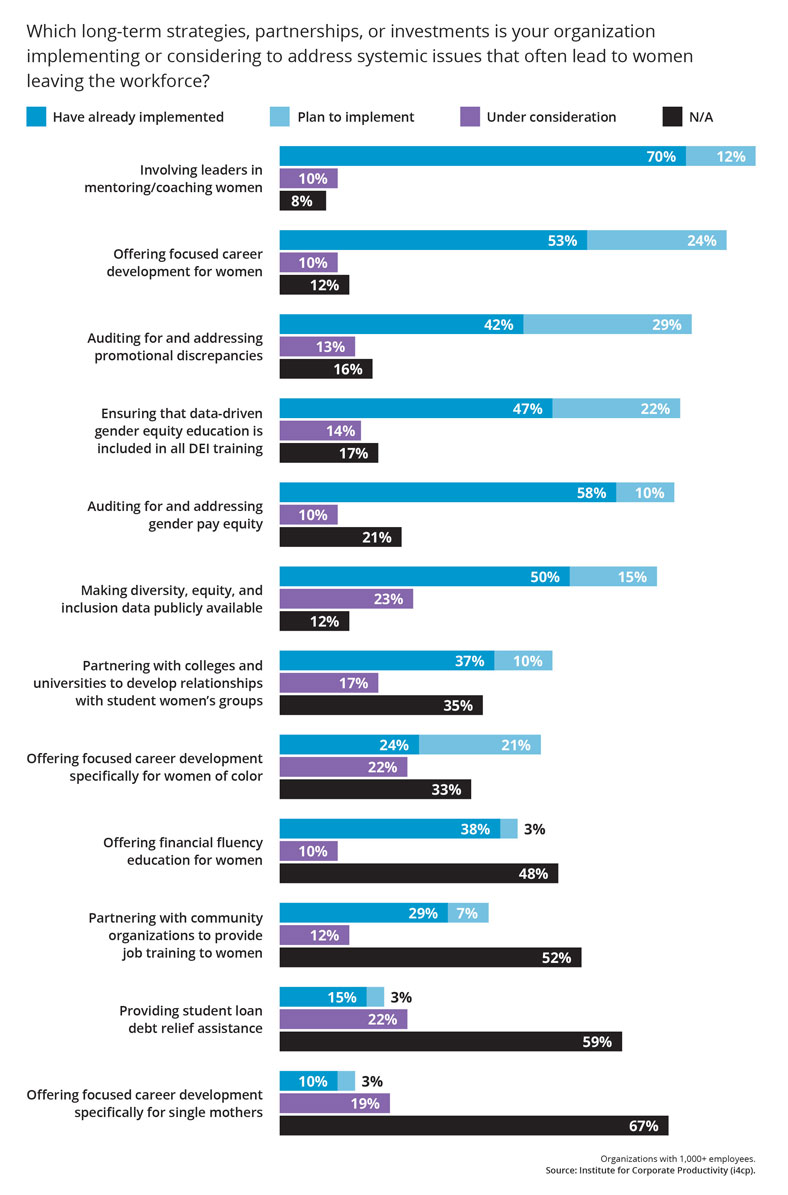Equity, Transparency, and Leadership Engagement Are Keys to Retaining Women

According to newly released data from the U.S. Census Bureau, between March and April of 2020, “3.5 million mothers with school-age children left active work—either shifting into paid or unpaid leave, losing their jobs, or exiting the labor market all together.” As of February 2021, nearly 1.5 million fewer moms of school-aged children were actively working than in the previous year. And as the Wall Street Journal reported this week, “during the depths of last year’s economic crisis, Bureau of Labor Statistics data show, women’s participation in the workforce fell to levels not seen since the mid-1980s.”
As we noted in March of this year, while many organizations are taking steps to alleviate the disparate impacts of the COVID-19 pandemic on women in their workforces, a recent survey by the Institute of Corporate Productivity (i4cp) found that among larger employers, the number of those taking action (42%) is nearly equal to those organizations that are not (40%).
Of the 400 professionals who participated in the survey exploring what employers are doing (if anything) to address issues that may contribute to women leaving their organizations, 256 represented large organizations (those with 1,000+ employees). An interesting note: The majority of those from larger organizations told us that the percentage of women in senior-most leadership roles in their companies is hovering at between 25-49%. Only 5% reported that their organizations had reached 50% representation or more.
While we obviously can’t claim causation here, we found by looking more closely at the data that organizations with more women at the top of the house are more likely to take action to address issues and stressors that prompt women to exit the workforce.
Direct leadership involvement is by far the most popular intervention
The top strategies survey participants reported are currently in place or about to be implemented in their companies to address issues that lead to women leaving the workforce are:
- 82% Involving leaders in mentoring/coaching women
- 77% Offering focused career development for women
- 71% Auditing for and addressing promotional discrepancies
- 69% Ensuring that data-driven gender equity education is included in all DEI training
- 68% Auditing for and addressing gender pay equity
Involving leaders in the coaching and mentoring of women has long been a prescribed strategy for developing women, supporting their career development, and enhancing retention, but there needs to be purposeful emphasis on intersectionality as well—coaching and mentoring of women of color, LGBTQ+, and others from underrepresented groups.
Why is the inclusion of data-driven gender equity education in diversity, equity, and inclusion training important, moreover, why are so many organizations ensuring this? Because despite all the research that has been published on this issue, gender pay equity remains a complex, hot button topic that requires thoughtful consideration, critical thinking, and context. Leading with data and objectivity is a sound strategy for those who seek to better understand the situation, how we got here, and what can be done to drive change.
Preventative actions that may be on the horizon
The top five strategies that aren’t in place but are currently under consideration to implement as means to address issues that often lead to women leaving the workforce are:
- 23% Making diversity, equity, and inclusion data publicly available
- 22% Offering focused career development specifically for women of color
- 22% Providing student loan debt relief assistance
- 19% Offering focused career development specifically for single mothers
- 17% Partnering with colleges and universities to develop relationships with student women’s groups
Taking decisive steps to formulate retention strategies for specific cohorts comes in many forms based on the issues and needs identified for an organization:
“We are at the beginning stage of a strategic approach to reducing attrition of women. We’ve developed a DE&I Index and are conducting women’s focus groups to better understand the needs,” one participant commented.
Another noted that their organization is actively recruiting women into leadership positions and providing women with high-profile assignments and opportunities that position them for recognition on a global scale.
Others mentioned renewed investment and attention to opportunities for portfolio and collaboration projects, frequent check-in conversations, coaching, mentoring, and opportunities for movement within the organization—actions that require consistent planning and intention but are well worth it.
As one survey participant: “Offering flexible work environment (flex time/remote working) as well as ongoing conversations and support between managers/employees to understand employees’ challenges has been simple yet very effective.”
Lorrie Lykins is i4cp's Vice President of Research







